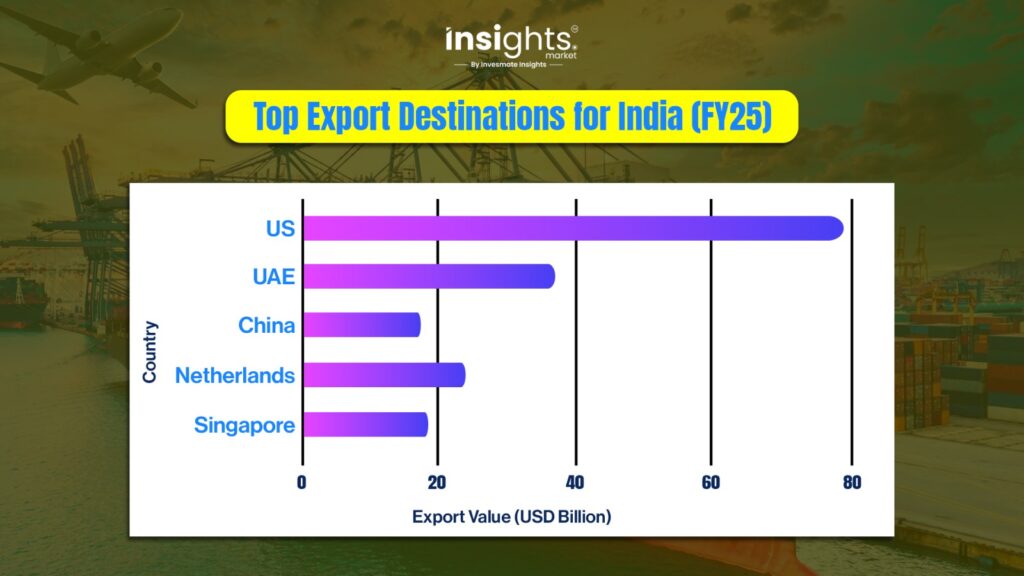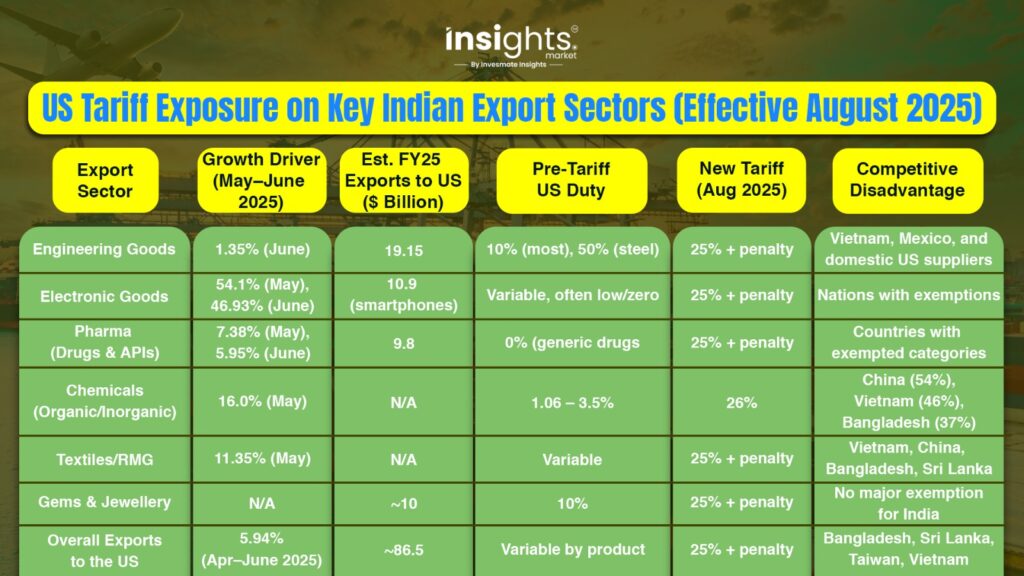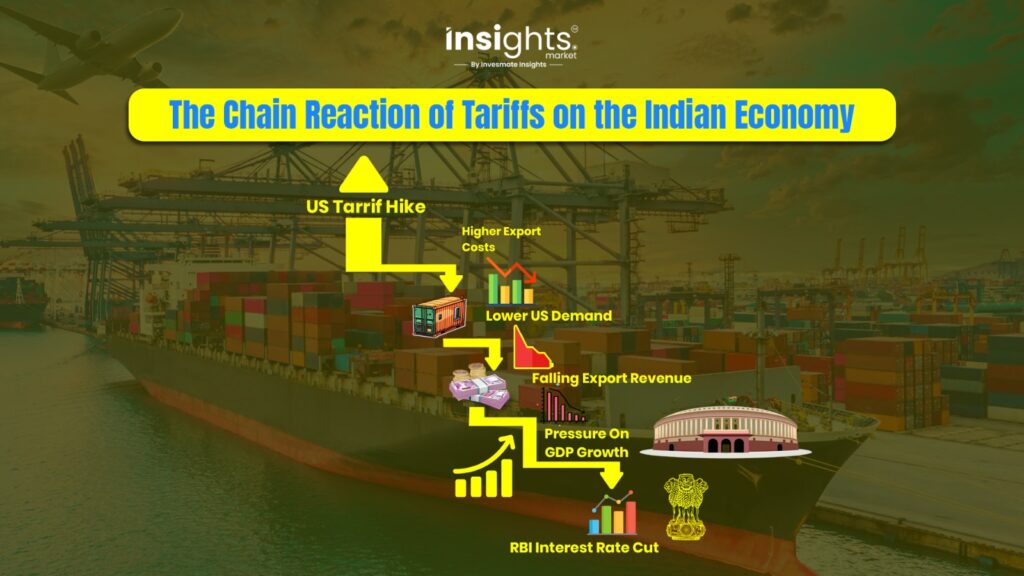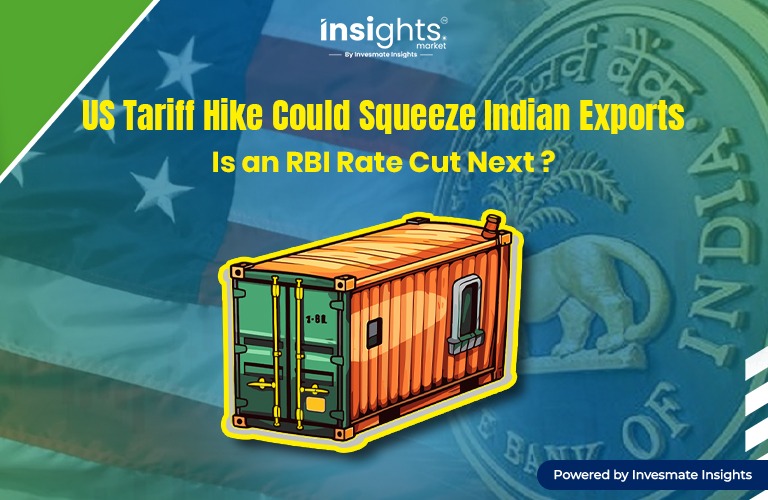![]()
One morning in August 2025, a textile exporter in Tamil Nadu checks his email and pauses. His US buyer, a long-time client, is now reconsidering future orders.
Across India, businesses in textiles, gems, auto parts, steel, and farm exports are assessing the same challenge.
The reason? Not because of quality or delivery, but due to new US import duties on Indian goods. The US has imposed a 25% tariff on several Indian products, raising costs and shaking up trade flows.
This policy shift also comes in a larger context—global trade realignments and geopolitical shifts, including India’s energy ties with Russia. The US has offered tariff relief to some nations, but India didn’t make the list this time. That’s led to concern, but also opened room for stronger regional and domestic trade strategies.
In other words, the US tariff hike brings fresh challenges.
This episode reminds us how global politics can affect local jobs, incomes, and growth, one tariff at a time. Let’s dive into it to know the details…
Indian exporters face a tough time ahead. The United States has raised tariffs by 25% on many Indian goods starting August 2025. This move could hit India’s export engine hard and may force the Reserve Bank of India (RBI) to cut interest rates soon.

India sends $87 billion worth of goods to the US each year. Many of these goods now face a new 25% tax. That means Indian companies must pay more to sell their products in America. This extra cost may push buyers to switch to cheaper options from other countries.
Sectors such as textiles, gems, jewellery, auto parts, steel, and farming products are the most exposed. Small and medium businesses in states like Tamil Nadu, Gujarat, Maharashtra, and Karnataka feel the heat. For example, textiles compete mainly on price. Higher tariffs threaten to make Indian textiles less attractive to US buyers.

Economists warn these tariffs could slow India’s growth. The country’s GDP could slow by as much as 0.5% or more. That means the economy may grow closer to 6% instead of the expected 6.5%. Stock markets and the rupee could also face pressure as export earnings decline.
Read More: Decoding Trump’s India Tariffs: Trade War or Hidden Opportunity for India?

The sectors below are among the most exposed. The new tariffs, combined with no exemptions and higher comparative duties, are likely to affect competitiveness, pricing, and order volumes.

Note: FY25 exports are based on available estimates for the fiscal year ending March 2025.
Source: Ministry of Commerce & Industry Department of Commerce, Compiled from trade and tariff reports as of July–August 2025.

What about the RBI? The central bank might cut interest rates to help the economy. Lower rates make borrowing cheaper. This can boost spending and investment when exports fall. The RBI has already cut rates to 5.5% in recent months. Experts expect more cuts soon—possibly between 0.5% and 0.75%—to soften the tariff blow.
Read More: RBI’s Bold Rate Cuts & CRR Slash: What It Means for Your Loans, Savings, and Wallet in 2025
Picture India’s export sector as a train speeding towards the US market. The new tariffs are like a heavy toll gate slowing down the train. To keep the goods moving, the train driver (RBI) may cut ticket prices (interest rates). The goal is to ease the strain and keep the economy on track.
This tariff increase comes at a sensitive time. It follows other trade tensions and is linked to political issues, like India’s energy deals with Russia. The US has sidestepped giving India the same tariff breaks offered to other countries, adding to worries about the trade outlook.
In short, Indian exporters face a tough challenge from the US tariff hike. This could slow economic growth and push the RBI to lower interest rates soon. Businesses and consumers alike may see benefits from these cuts as India adapts to a tougher trade environment.
The story shows how global politics and economics connect.
Tariffs may seem distant, but their impact touches millions of jobs and shapes the nation’s future growth.
It’s not a dead end. With smart policy moves and business adaptability, India can stay on track—and perhaps even discover new routes to growth.
FAQs
The United States has imposed a 25% tariff on many Indian goods, starting in August 2025. This makes Indian products more expensive in the US, impacting key export sectors.
The tariff increase raises costs for Indian exporters and could lead to lost orders as US buyers may switch to cheaper suppliers from other countries. Sectors like textiles, gems, jewellery, auto parts, steel, and agriculture are most affected.
Industries that export heavily to the US, such as textiles, gems and jewellery, auto components, steel, and agricultural products, are the most at risk from the new tariffs.
Yes, experts believe the Reserve Bank of India (RBI) may cut interest rates further to support the economy and help exporters cope with softer demand and higher costs caused by the tariffs.
Economists estimate that the new US tariffs could reduce India’s GDP growth by up to 0.5 percentage points, potentially bringing growth below earlier forecasts.
Exporters may look for new markets, diversify products, and invest in cost reduction to remain competitive. They may also seek government support during this period.
The US did not give India tariff relief provided to other regions like Japan and the EU, possibly due to ongoing trade and geopolitical issues, including India’s ties with Russia.
A rate cut by the RBI would make loans cheaper, encouraging investment by businesses and spending by consumers, which can help offset the export slowdown.
Yes, the rupee could come under pressure if export earnings decline and foreign investors become cautious due to lower growth prospects.
For the latest news, follow reputable sources such as government trade portals, business news websites, and RBI policy updates.




